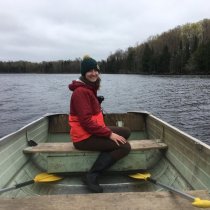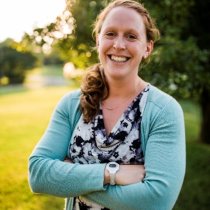Spotlight
Women in Ecology – Monica Papes
August 12, 2020
As we continue to hold conversations with Women in Ecology, some familiar themes continually appear: the importance of representation in STEM fields, the role mentors play in shaping future scientists, and the urgency climate change is placing on many researchers’ work. All of these aspects can influence a young scientist’s career path – for better or worse.
We sat down to discuss these topics with Dr. Monica Papes, assistant professor and Spatial Analysis Lab Director at the University of Tennessee Knoxville. Papes spoke with us about how an encouraging student advisor provided her with opportunities that changed the focus of her research, and how a more diverse department helps her to feel confident about her place in academia.
Q: What inspired you to become involved in your current research/field?
I had several sources of inspiration along the way. I had great undergraduate and graduate mentors, enthusiastic graduate students in my cohort, and supportive fellow researchers. Reading exciting papers that harness the power of statistical modeling and remote sensing to study species’ distributions made me want to contribute to the fields of ecology and conservation.
Q: Please tell us a little about your career path.
I went to college in my hometown, Timisoara, in Romania. I had been interested in biology since middle school so I loved studying for my B.A. in biology. I was fortunate to participate in a couple of research projects on avian behavior and ecology as an undergraduate researcher in my last two years in college. After graduating, I decided to further my education with a master’s degree at the University of Kansas under the mentorship of Dr. A. Townsend Peterson. This incredible opportunity made me realize that I would enjoy a research-based career.
During my time as a PhD student I had numerous amazing, career-defining opportunities, all enabled by my advisor. An Organization for Tropical Ecology field course inspired me to shift my master’s work in predicting potential distributions of species in Central and Eastern Europe and how well current protected areas are placed relative to threatened bird species. Because I was emotionally tied to Central and Eastern Europe, I did this project, but after my first master’s year I had the opportunity to take this course because my advisor helped me – including finding financing – and while I was there I was just amazed at the complexity of tropical ecosystems. I started thinking about the migration of various birds, and that launched me into my PhD work. My pursuit of a research-focused career followed the usual path: I was a postdoctoral researcher at University of Wisconsin in the Center for Limnology, then assistant professor at Oklahoma State University, and currently I’m seeking tenure at the University of Tennessee.
Q: Who were your most important influences/mentors in ecological science?
I had a number of mentors: My graduate advisor Dr. A Townsend Peterson; Dr. George Powell (WWF senior scientist); Dr. Greg Asner (remote sensing scientist at Arizona State University); Dr. Jorge Soberón (ecologist, University of Kansas); Dr. Jake Vander Zanden (limnologist, University of Wisconsin); and Dr. Erica Marín-Spiota (biogeochemist, University of Wisconsin)
Q: What challenges do you think women may face getting into STEM fields? Have you experienced or overcome any of these?
I think fields that are not mirroring the diversity of the general population are more intimidating to junior scientists. Thankfully, I did not experience challenging situations until I was in my first assistant professor position. The sense of being the right person for the job was at times challenged by my interactions with some colleagues. If in faculty meetings most voices are male voices and there are only a few women at the table, then there is less sense of belonging and it’s like imposter syndrome. That’s hard because if you’re in the minority, you think you don’t belong. The gender ratio is better now and you hear women speaking up in a meeting and don’t feel out of place. I have colleagues I talk with about this, and I have a friend who left academia after getting tenure because they don’t feel valued.
Q: How can research and educational institutions inspire more women to study fields in ecology?
I think it is important to create opportunities for undergraduate research experience early on. Increasing institutional diversity can also encourage more women to pursue ecology-related degrees and research opportunities. The retention issue is quite serious in biological fields—representation at the undergrad level is great, and many classes have more female undergrads than male. The ratio is not a problem even at the graduate level, depending on the program and the department. But when you visit a department as a grad student and it’s lopsided toward male faculty you could feel less welcome.
In Romania I never thought about gender representation, but looking back, the undergraduate biology degree was heavily dominated by women—there were two men and 23 women! But our department professors were almost all male. Here in the U.S., I had a prospective grad student who was interviewing with our department and she said I was the first female professor she met with, and she asked how do you feel here, is your voice heard? I realized we made a huge mistake in just looking at professors’ availability and then matching these student based on schedules, and we missed one very important detail—prospective students should get a feel for the overall diversity of the department.
Another issue we talk about is work-life balance, but it’s not a clear conversation. If you work more hours and publish more, you get more grants and are more successful. So, unless everyone applies the same work-life balance then this situation will persist where researchers struggle to have families and careers.
Q: What work are you most proud of at this point in your career?
My dissertation work on spectral separation of emergent tropical trees is near and dear to my heart because I view it as my most independent, engaging, technologically difficult, and cutting-edge work. I was asking why do these tropical birds migrate short distances, rather than long distances? And I thought “I wonder if it’s seasonality of fruiting trees and other factors?” It’s the tropics; the perception is that there isn’t seasonality there. Can we quantify productivity and seasonality of phenology of various tress? Can we do that remotely from satellite images? I used a multispectral sensor that collects data every day. In order to see differences in vegetation from space, I’m after a signal that’s very hard to quantify, i.e. flowering or fruiting. Finer spectral resolution images require hyperspectral images and there was only one experimental sensor, so data was not available freely and it wasn’t collected regularly. And cloud cover in the tropics also made satellite data collection very hard. It made me very proud to analyze this data and understand tree canopies spectrally.
Q: What do you hope to do in your field in the future?
My research is interdisciplinary, combining ecological niche modeling, remote sensing, and GIS in ecology and conservation studies. My hope is to integrate local scale environmental predictors into broad scale estimates of biodiversity distribution. My current research interest and efforts are focused on developing estimates of microclimatic conditions that can be incorporated in broad scale models of ecological niches.
This is where NEON comes in; it enables all ecologists interested in hyperspectral data to be able to use it. NEON also has lidar which gets to the microclimate data. In the interdisciplinary direction I’m going, spectral diversity is informing us about species diversity, then lidar informs microclimate conditions, and finally those conditions help us improve our models of where species are. Most of us are using models interpolated at large scales. My hope is to create variables that quantify these microclimatic conditions from the structure of the habitat.
Q: What is the most satisfying part of being an ecologist? What is the most challenging?
I enjoy thinking about interactions between organisms and environments, and my job allows me to do that on a daily basis. Why is an organism found where it’s found? I try to make sense of species distributions and assemblages. Other aspects I enjoy are being able to talk to like-minded researchers and exchange ideas, and to have the sense of us all trying to make progress.
The most challenging part in my view is keeping up with technological and analytical advancements that ultimately enable an ecologist to generate conceptual breakthroughs. Technology advances very fast thankfully, but it’s hard to keep up because there’s less and less time for us to learn new techniques as we have more responsibilities.
Q: Can you tell us more about your work on understanding the effects of human system processes on natural systems?
My research interests include investigating potential effects of climate change on species’ distributions. Land use is another anthropogenic factor that influences the distribution of organisms, and that I consider in my research. Thus, my work evaluates the effect of human actions on distributional patterns of biodiversity.
Q: What is the most alarming discovery you have made? What is the most promising?
Regardless of which climate change scenario is considered (various levels of low, moderate, or high changes in temperature and precipitation), the future potential distributions of many of the species I studied with ecological niche models are estimated to shift, decrease, and in some cases, increase in total area. These results worry me because it is very difficult to forecast community reassembly and ecosystem-level effects of such distributional changes. Generally, for many of the species that I worked with, we see predictions of loss of potential distribution areas, and it’s concerning not just because some species might go extinct or have a reduction in their range, but also it’s very hard to understand in terms of reassembly of communities and functional changes in ecosystems. That is alarming because the number of species that are already showing distributional sensitivity to changes in climate is quite high, and we have no idea what it means for ecosystems.
I am hopeful that microclimatic conditions in some situations have the capacity to mitigate changes in large-scale climatic conditions, but my work in the field of microclimates has just begun. The hope is that microclimatic conditions will help some species to be resilient to climate change. A recent paper in Science noted microclimate conditions as a more important predictor than expected, but we’re at the beginning of understanding the value of these conditions.



